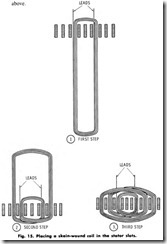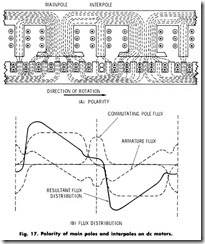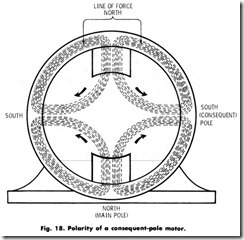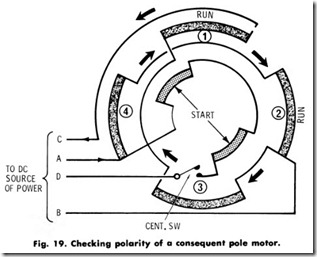PLACING COILS IN SLOTS
Single-Phase Stator
1. Distributed windings. For distributed windings follow the pro cedure outlined in paragraph on Coil Forming earlier in the chapter.
2. Skein windings. The coil is made large enough to be wound into all the slots necessary to complete the individual sections of a pole. The advantage of this method lies in the fact that many conductors may be placed in the slot at one time. After the skein
coil is removed from the form, follow the outline procedure:
a. Place one end of the skein in the slots of the smallest pitch, as illustrated in 1, Fig. 15.
b. Half-twist the coil in the opposite direction.
c. Place the free sides of the skein into the slots of the next larger pitch, as illustrated in 2, Fig. 15.
d. Half-twist the coil in the opposite direction.
e. Place the free sides of the skein into the slots of the next larger pitch, as illustrated in 3, Fig. 15.
f. Tightly wedge the winding.
g. Proceed to the next pole and follow a to f above.
h. Follow a to f above for every pole until the stator is complet ed.
i. When a skein coil is placed in the same slot two or three times, follow the same procedure in a to h, above; except, place double or triple coils in slots as shown in Fig. 16.
Polyphase Stator
With one exception, the procedure in paragraph headed Placing Armature Coils in Slots in Chapter 15, can be used for placing coils in stator slots. Because of the spacing limitations inside the stator bore, all the first sides of a coil cannot be placed in the stator. Follow the added procedure outlined below:
1. Place first sides of coils into the slots in the amount of one or two more coils than the pitch of one coil.
2. Place a strip of insulation 0.020 inch thick, 1/4 inch (6mm) wider, and 1 inch (25 mm) longer than the slot on top of the first coil side on which the second coil side of another coil, several away (according to coil pitch), is to be placed.
3. Place the second side of a coil (according to coil pitch) into the proper slot on top of the insulation on a first coil side.
4. Place the first side of another coil in the slot adjacent to the slot in which a second coil side has just been placed, and repeat 2 and 3 above.
5. Continue, following 2, 3 and 4 above, until the entire stator is completely wound.
6. Fold in all the slot feeders as described in Chapter 15.
7. Wedge the windings as described in Chapter 15.
8. For open slots using taped coils, it is not necessary to insulate between coil sides.
CONNECTIONS
The connections are made compact, mechanically secure, and well insulated. If stranded wires are connected to solid wires, care must be exercised to make certain that no strands are left unconnected or are severed or broken near the connection. Every strand of a stranded conductor must be incorporated in a connection for maximum current carrying efficiency.
Connection of Coils
The procedure for interconnections of coils is given below:
Polarity: Field Poles and lnterpoles. The field poles of a de motor or generator and of an ac motor, generator, or synchronous motor must be alternately north or south around the pole faces of the
machine .
Where interpoles are used in de generators, the interpole following the main pole, in the direction of rotation, is of opposite polarity to the main pole. However, in de motors, the interpole following the main pole must have the same polarity as the main pole, this being opposite to the corresponding rotation in de generators. The commutating flux thus obtained from the inter poles, together with the armature flux, produces the proper resultant flux by which sparkless commutation is obtained without shifting brushes. Fig. 17.
1. Consequent Poles. In some ac motors, the poles are connected so that the adjacent poles have the same polarity. The magnetic effect of this is to produce twice as many magnetic poles as there are wound poles. Each wound pole produces a pole of opposite polarity betweeen the coils as a result of this magnetic flux, Fig.18.
When connected in this manner, they are called consequent poles. This principle is used to produce a two-speed motor by arranging the connections between the poles so that, when the switch is thrown in one direction, the wound poles will have alternate polarity, and when thrown in the opposite direction, they will have the same polarity. This principle is also used to double the number of poles in the starting winding of a split-phase motor.
2. Checking for Proper Connections. Proper connections are directly related to proper polarity.
Magnetic compass method of checking polarity of a consequent pole motor. Fig. 19 shows a schematic diagram of a typical two-speed, split-phase motor with the running winding connected series-consequent.
a. Connect line terminals A and C to a low voltage, de source (about 20 percent of operating current). This connects the four coils of the running winding in series with the current flowing in the same direction as indicated by the arrows. The starting winding should be left open at B,D and the centrifugal switch.
b. Magnetic compass needle placed alternately at points 1 to 4, Fig. 19, should show similar polarity.
c. If a similar polarity is not registered at the four poles, check to make sure windings are not reversed, and make proper con nections.
Connection of Internal Switches
Some internal switches come equipped with binding screws. When making connection to these, be certain that the end of the conductor is bent around the screw in the direction in which the screw tightens, and that the screw is driven in as tight as possible without stripping the threads. Other internal switches are equipped with soldering lugs or leads. It is important at this time, to use the diagram developed during disassembly of a unit for reconnection.
Capacitor Types
Some of the many types of capacitor motors are listed below. Some of these types are designed to operate on one voltage, others on two voltages. Many of them are externally reversible; others can only be reversed, internally. In any case, motor reversal on split phase induction motors can be obtained only by reversing the relationship of the starting winding and the running winding, whether done externally or inter nally. The capacitor for starting is in series with the starting winding and, if and when changes are made for reversal of direction, it must be remembered to place the capacitor in series with the starting winding at some point of connection. The various types of capacitor-start motors are:
1. Single-voltage, externally reversible.
2. Single-voltage, nonreversible.
3. Single-voltage, reversible, with thermostat.
4. Single-voltage, nonreversible, with magnetic switch.
5. Two-voltage, reversible.
6. Two-voltage, nonreversible.
7. Two-voltage reversible, with thermostat.
8. Single-voltage, three-lead, reversible.
9. Single-voltage, instantly reversible. 1 0 . Two-speed.
1 1 . Two-speed, two capacitor.
USE OF ELECTROLYTIC CAPACITORS
In all of the listed types, electrolytic capacitors are used. Virtually two motors exist with the two-speed, two-capacitor type. In this type of motor there are two starting windings and two running windings. Each of the capacitors is connected in series with each of the starting windings and a centrifugal switch common for both windings. At this time, the diagram developed during disassembly of a unit is used for reconnection.
TESTING
It is important to test a stator, after winding, for shorts, opens, or grounds. If all the precautions are observed and carried out in the rewinding procedure, the possibility of trouble is minimized.
SUMMARY
Recording data is one of the most important steps in rewinding a stator or coil. Forms are available for getting the correct information recorded. Single-phase motors with more than four poles are a rarity, but there are motors with six and eight poles. They deserve special attention before stripping for a rewind job.
The procedure for insulating the slots in a stator of a single-phase motor is similar to that used for armatures. Most single-phase motors are handwound. There are however, a number of ways to rewind single-phase motors. Form winding can be used as can skein winding, Most polyphase fractional horsepower motors are diamond-shaped, mush-wound coils arranged in lap winding. Connections are made compact, mechanically secure, and well insulated. If stranded wires are connected to solid wires, care must be exercised to make certain that no strands are left unconnected or are severed or broken near the connection.
There are eleven types of capacitor start motors. Some are reversible and some are not. One type is virtually two motors in one frame since it has two capacitors and two starting windings.
REVIEW QUESTIONS
1. What is the most important step in rewinding a stator or coil?
2. How many poles do single-phase motors usually have?
3. Why are most single-phase motors handwound?
4. What are the two other types of winding which can be used to wind a single-phase motor?
5. What is a skein winding?
6. What three things should a connection be checked for?
7. What is a consequent pole?
8. List the 11 types of capacitor-start motors.




